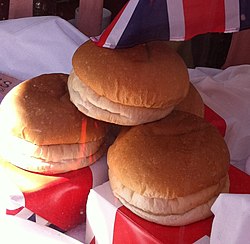
A muffin or bun is an individually portioned baked product; however, the term can refer to one of two distinct items: a part-raised flatbread that is baked and then cooked on a griddle, or a quickbread that is chemically leavened and then baked in a mold. While quickbread "American" muffins are often sweetened, there are savory varieties made with ingredients such as corn and cheese, and less sweet varieties like traditional bran muffins. The flatbread "English" variety is of British or other European derivation, and dates from at least the early 18th century, while the quickbread originated in North America during the 19th century. Both types are common worldwide today.
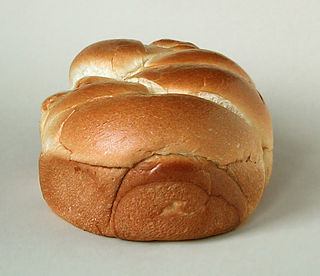
Brioche is a pastry of French origin whose high egg and butter content gives it a rich and tender crumb. The chef Joël Robuchon described it as "light and slightly puffy, more or less fine, according to the proportion of butter and eggs". It has a dark, golden, and flaky crust, frequently accentuated by an egg wash applied after proofing.

A hot cross bun is a spiced bun, usually containing small pieces of raisins and marked with a cross on the top, which has been traditionally eaten on Good Friday in the United Kingdom, Ireland, Australia, New Zealand, South Africa, Canada, India, Pakistan, Malta, United States and the Commonwealth Caribbean. They are available all year round in some countries, including the UK.

An English muffin is a small, round and flat yeast-leavened bread which is commonly 4 in (10 cm) round and 1.5 in (4 cm) tall. It is generally split horizontally and served toasted. In North America, Australia, New Zealand and the United Kingdom, it is frequently eaten with sweet or savoury toppings such as butter, fruit jam, honey, eggs, sausage, bacon, or cheese. English muffins are an essential ingredient in eggs Benedict and a variety of breakfast sandwiches derived from it, such as the McMuffin.
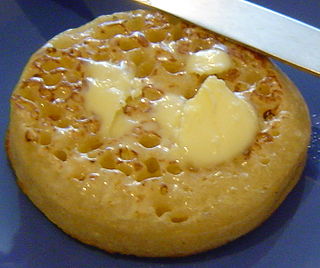
A crumpet is a small griddle bread made from an unsweetened batter of water or milk, flour, and yeast, popular in the United Kingdom, Australia, Canada, New Zealand, and South Africa.
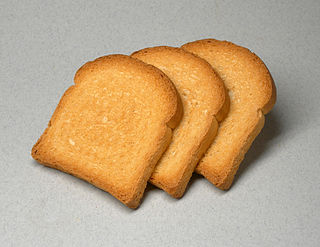
A rusk is a hard, dry biscuit or a twice-baked bread. It is sometimes used as a teether for babies. In some cultures, rusk is made of cake, rather than bread: this is sometimes referred to as cake rusk. In the UK, the name also refers to a wheat-based food additive.
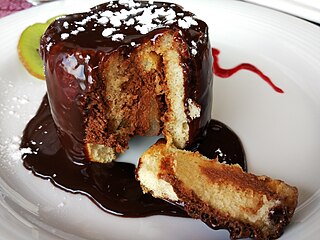
A charlotte is a type of bread pudding that can be served hot or cold. It is also referred to as an "icebox cake". Bread, sponge cake, crumbs or biscuits/cookies are used to line a mold, which is then filled with a fruit puree or custard. The baked pudding could then be sprinkled with powdered sugar and glazed with a salamander, a red-hot iron plate attached to a long handle, though modern recipes would likely use more practical tools to achieve a similar effect.

The Bath bun is a sweet roll made from a milk-based yeast dough with crushed sugar sprinkled on top after baking. Variations in ingredients include enclosing a lump of sugar in the bun or adding candied fruit peel, currants, raisins or sultanas.

Cozonac or Kozunak is a sweet yeast dough that can be used to make different traditional holiday breads and cakes. Often mixed with raisins or nuts, it can be baked as a loaf or rolled out with fillings like poppy seed or walnuts. It is common throughout Southeastern Europe in countries such as Romania, Moldova, Bulgaria, Serbia, North Macedonia and Greece. Rich in eggs, milk and butter, it is usually prepared for Easter in Romania, Serbia, Bulgaria, and in Romania and Moldova it is also traditional for Good Friday, in a simplified version with vegan ingredients, without eggs or milk - named Cozonac de post - to be eaten by Christians during lent. The name comes from the Bulgarian word for hair-коса/kosa, or Greek: κοσωνάκι, romanized: kosōnáki, a diminutive form of κοσώνα, kosṓna.
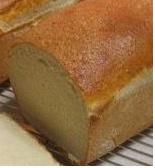
Manchet, manchette or michette is a wheaten, yeast-leavened bread of very good quality, or a small flat circular loaf. It was a bread that was small enough to be held in the hand.
There are many geographically indicated foods of the United Kingdom. In British cuisine, there is a custom of naming foodstuffs with reference to their place of origin. However, there are other reasons for this practice; Scotch egg, which was invented in London and Dover sole which indicates where they were landed, for example.

Monkey bread is a soft, sweet, sticky pastry served in the United States for breakfast or as a treat. It consists of pieces of soft baked dough sprinkled with cinnamon. It is often a midmorning/breakfast food and usually served at fairs and festivals.

English Bread and Yeast Cookery is an English cookery book by Elizabeth David, first published in 1977. The work consists of a history of bread-making in England, improvements to the process developed in Europe, an examination of the ingredients used and recipes of different types of bread.
Korean baked goods consists of either snacks or bread. Examples include bread, buns, pastries, cakes, and snacks.
Victorian cuisine is the cuisine that was widespread in Britain during the Victorian era.
